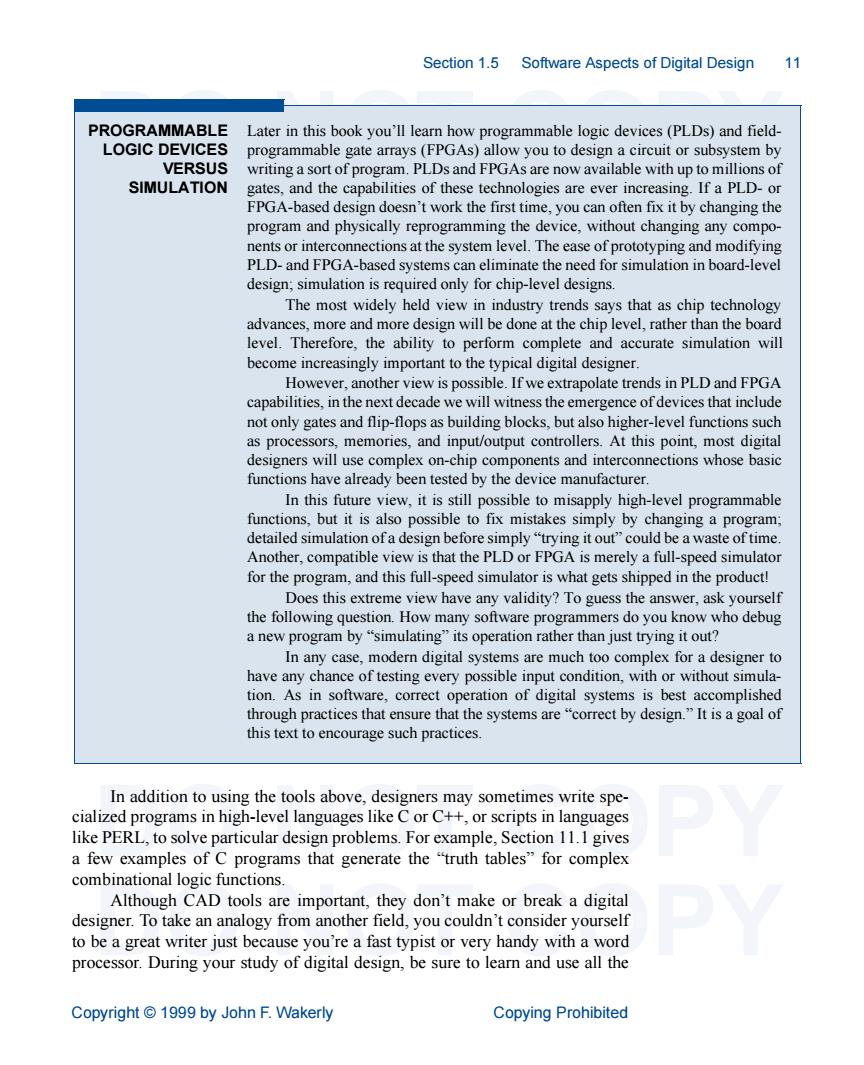正在加载图片...

Section1.5 Software Aspects of Digital Design 11 PROGRAMMABLE Later in this book you'll learn how programmable logic devices(PLDs)and field- LOGIC DEVICES programmable gate arrays(FPGAs)allow you to design a circuit or subsystem by VERSUS writing a sort of program.PLDs and FPGAs are now available with up to millions of SIMULATION gates,and the capabilities of these technologies are ever increasing.If a PLD-or FPGA-based de n doesn't work the first time,you can often fix it by changing the the system level.The ease of prototypng and modifyng PLD-and FPGA-based systems can eliminate the need for simulation in board-level design;simulation is required only for chip-level designs. The most widely held view in industry trends savs that as chip technology advances.more and more design will be done at the chip level.rather than the board level.Therefore.the ability to perform complete and accurate simulation will become increasingly important to the typical digital designer However,another view is possible.If we extrapolate trends in PLD and FPGA capabilities.in the next decade we will witness the emergence of devices that include not only gates and flip-flops as building blocks,but also higher-level functions such as processors.memories.and input/output controllers.At this point,most digital designers will use complex on-chip components and interconnections whose basic functions have already been tested by the device manufacturer In this future view.it is still possible tomisapply high-level programmable functions,but it is also possible to fix mistakes simply by changing a program; detailed simulation ofa design before simply"trying it out"could be a waste oftime Another.compatible view is that the Pld or FPGA is merely a full-speed simulator for the program.and this full-speed simulator is what gets shipped in the product! Does this extreme view have any validity?Toguess the the following qu In any case modern digital systems are much too complex for a designer to have any chance of testing every possible input condition,with or without simula- tion.As in software,correct operation of digital systems is best accomplished through practices that ensure that the systems are"correct by design."It is a goal of this text to encourage such practices In addition to using the tools above,designers may sometimes write spe- cialized programs in high-evel languages in languages like PERL,to solve particular design problems.For example,Section 11.1 gives a few examples of C programs that generate the "truth tables"for complex combinational logic function Although CAD tools are important,they don't make or break a digital designer.To take an analogy from another field,you couldn't consider yourself to be a great writer just because you're a fast typist or very handy with a word processor.During your study of digital design,be sure to leamn and use all the Copyright 1999 by John F.Wakerly Copying ProhibitedSection 1.5 Software Aspects of Digital Design 11 DO NOT COPY DO NOT COPY DO NOT COPY DO NOT COPY DO NOT COPY DO NOT COPY DO NOT COPY DO NOT COPY DO NOT COPY Copyright © 1999 by John F. Wakerly Copying Prohibited In addition to using the tools above, designers may sometimes write specialized programs in high-level languages like C or C++, or scripts in languages like PERL, to solve particular design problems. For example, Section 11.1 gives a few examples of C programs that generate the “truth tables” for complex combinational logic functions. Although CAD tools are important, they don’t make or break a digital designer. To take an analogy from another field, you couldn’t consider yourself to be a great writer just because you’re a fast typist or very handy with a word processor. During your study of digital design, be sure to learn and use all the PROGRAMMABLE LOGIC DEVICES VERSUS SIMULATION Later in this book you’ll learn how programmable logic devices (PLDs) and fieldprogrammable gate arrays (FPGAs) allow you to design a circuit or subsystem by writing a sort of program. PLDs and FPGAs are now available with up to millions of gates, and the capabilities of these technologies are ever increasing. If a PLD- or FPGA-based design doesn’t work the first time, you can often fix it by changing the program and physically reprogramming the device, without changing any components or interconnections at the system level. The ease of prototyping and modifying PLD- and FPGA-based systems can eliminate the need for simulation in board-level design; simulation is required only for chip-level designs. The most widely held view in industry trends says that as chip technology advances, more and more design will be done at the chip level, rather than the board level. Therefore, the ability to perform complete and accurate simulation will become increasingly important to the typical digital designer. However, another view is possible. If we extrapolate trends in PLD and FPGA capabilities, in the next decade we will witness the emergence of devices that include not only gates and flip-flops as building blocks, but also higher-level functions such as processors, memories, and input/output controllers. At this point, most digital designers will use complex on-chip components and interconnections whose basic functions have already been tested by the device manufacturer. In this future view, it is still possible to misapply high-level programmable functions, but it is also possible to fix mistakes simply by changing a program; detailed simulation of a design before simply “trying it out” could be a waste of time. Another, compatible view is that the PLD or FPGA is merely a full-speed simulator for the program, and this full-speed simulator is what gets shipped in the product! Does this extreme view have any validity? To guess the answer, ask yourself the following question. How many software programmers do you know who debug a new program by “simulating” its operation rather than just trying it out? In any case, modern digital systems are much too complex for a designer to have any chance of testing every possible input condition, with or without simulation. As in software, correct operation of digital systems is best accomplished through practices that ensure that the systems are “correct by design.” It is a goal of this text to encourage such practices